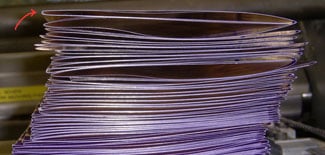To paraphrase Confucius, the way a double gatefold plate works is really simple but our explanations make it sound complicated. Words just don’t cut it. Many processes in print finishing are easier to understand with a decent photo, video, diagram, or analogy. The action behind a double gate fold (also called a closed gatefold) running automatically on a buckle folding machine is one of those things.
I ran across a video animation which does a beautiful job of presenting the detailed action of a double gatefold plate in slow-motion detail. Although the video shows a Heidelberg Stahl folder, the concept is the same for all automatic plates.
The fold is as follows:
- Up about 1 panel length into the first plate
- Up about 2 panel lengths into the third plate
- Down 1 panel length into the fourth gatefold plate
The first two folds are conventional buckle folds. These are easy to set. The last fold has a timed element. As you can see, there is a mechanism that tucks the panels in at the last fold at the precise moment the  fold arrives at the buckle point. Without this, one panel will open up as the last fold is made. It’s a simple, clever gadget that does a great job, as long as everything is set correctly.
fold arrives at the buckle point. Without this, one panel will open up as the last fold is made. It’s a simple, clever gadget that does a great job, as long as everything is set correctly.
If you’re methodical about your setup, you shouldn’t have any problem. Of course, there is a benefit to having some experience doing this since it doesn’t take much for things to go wrong.
With that in mind, here are several things to be aware of when you’re setting up the folder.
1) Check that folds 1 and 2 are running perfectly, in the correct position and with perfect register. You will need to leave the gatefold plate out to properly check the sheets. If the first two folds aren’t right, you’ll never get your automatic plate set correctly. Also be sure to follow the manufacturer’s troubleshooting and setup instructions regarding their plate.
2) Use minimum pressure on fold roller #4, just enough to drive the sheet into the gatefold plate. Too much pressure here can cause a boxed fold. We discussed boxed folds in a previous article. Today we’re going into a little more detail than we did in that article.
3) This is the key piece: open the gap substantially on fold roller #5 and on the slitter shaft. Instead of 4 sheets, use 6-8 sheets or even 10 if needed. By removing all pressure from the folded piece, the bubbled panel will have a split second to relax as it pops through fold roller #5, thus leaving fold #1 intact. At this point all three folds are complete and fold roller 5 is merely moving the sheet and not doing any of the folding work.
 With too much pressure, the result is the boxed fold shown in the photo on the right. It helps to visualize the folding process if you remember that buckle folders drive or push the paper through the machine, more so than pulling it.
With too much pressure, the result is the boxed fold shown in the photo on the right. It helps to visualize the folding process if you remember that buckle folders drive or push the paper through the machine, more so than pulling it.
4) In #3 above we opened up the slitter shaft gap substantially but you can also do this: offset the pull out wheels so the upper wheels don’t contact the lower wheels, or move them out of the way entirely. Pull out wheels can also cause a box fold, depending on the final size of the piece.
Once the machine is set, you can always move the pull out wheels back into position. If the boxed fold returns, you’ll have to open up the slitter shaft gap more, or make do without them. But that should be fairly easy with most styles of folder deliveries.
5) Panels can catch or bend on the gate-fold mechanism. First check the timing. If you set the first two folds correctly and they’re running consistently, it’s likely the timing is at fault. Next check the curl of the paper. If you have a heavy curl away from the fold, you might have to curl the lead edge of the sheet inward, towards the fold.
6) Adjust folding machine speed as needed. This almost goes without saying whenever we’re talking about folding problems. Speed affects the force behind a fold. You might need a bit more force for cover stocks and a bit less for very light text stocks.
7) If you’re folding cover stocks, or even bulkier text stocks, make sure they have a good crease (such as a Tri-Creaser) or score in them. Make sure the register is perfect. If the crease is bouncing around, or the trimming is poor, you’ll struggle with the gate fold process just as you would with a conventional fold.
8) Leave enough gap between sheets according to manufacturer’s directions. Photocells control the timing of the fold plate. If the gap is too small it can mess up the timing. You’ll normally have to leave a bit more gap than for regular folding. The manufacturers have very specific directions for running a gatefold plate well. Don’t ignore them.
If you’re trying to understand automatic gate folding, or if you’re trying to teach it to someone, then be sure to check out this video from Carlos Garcia’s youtube channel. Thanks also to Dave Double of Double Equipment for his contribution to the topic. Enjoy the video and feel free to leave your comments, suggestions, and stories below.


